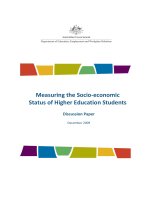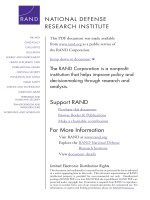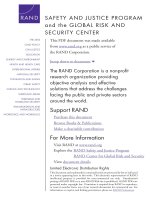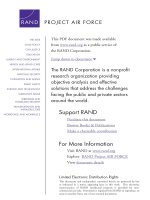THE ARTS CHILD POLICY CIVIL JUSTICE EDUCATION ENERGY AND ENVIRONMENT HEALTH AND HEALTH CARE docx
Bạn đang xem bản rút gọn của tài liệu. Xem và tải ngay bản đầy đủ của tài liệu tại đây (784.54 KB, 187 trang )
This document and trademark(s) contained herein are protected by law as indicated
in a notice appearing later in this work. This electronic representation of RAND
intellectual property is provided for non-commercial use only. Unauthorized
posting of RAND PDFs to a non-RAND Web site is prohibited. RAND PDFs are
protected under copyright law. Permission is required from RAND to reproduce,
or reuse in another form, any of our research documents for commercial use. For
information on reprint and linking permissions, please see RAND Permissions.
Limited Electronic Distribution Rights
Visit RAND at www.rand.org
Explore the RAND National Defense
Research Institute
View document details
For More Information
This PDF document was made available
from www.rand.org as a public service of
the RAND Corporation.
6
Jump down to document
THE ARTS
CHILD POLICY
CIVIL JUSTICE
EDUCATION
ENERGY AND ENVIRONMENT
HEALTH AND HEALTH CARE
INTERNATIONAL AFFAIRS
NATIONAL SECURITY
POPULATION AND AGING
PUBLIC SAFETY
SCIENCE AND TECHNOLOGY
SUBSTANCE ABUSE
TERRORISM AND
HOMELAND SECURITY
TRANSPORTATION AND
INFRASTRUCTURE
WORKFORCE AND WORKPLACE
The RAND Corporation is a nonprofit
institution that helps improve policy and
decisionmaking through research and
analysis.
Purchase this document
Browse Books & Publications
Make a charitable contribution
Support RAND
This product is part of the RAND Corporation monograph series.
RAND monographs present major research findings that address the
challenges facing the public and private sectors. All RAND mono-
graphs undergo rigorous peer review to ensure high standards for
research quality and objectivity.
Prepared for the Office of the Secretary of Defense
Approved for public release; distribution unlimited
NATIONAL DEFENSE RESEARCH INSTITUTE
Christopher Paul • Colin P. Clarke • Beth Grill
Victory
Has a
Thousand
Fathers
Sources of Success in Counterinsurgency
The RAND Corporation is a nonprofit research organization providing
objective analysis and effective solutions that address the challenges facing
the public and private sectors around the world. RAND’s publications do
not necessarily reflect the opinions of its research clients and sponsors.
R
®
is a registered trademark.
© Copyright 2010 RAND Corporation
Permission is given to duplicate this document for personal use only, as
long as it is unaltered and complete. Copies may not be duplicated for
commercial purposes. Unauthorized posting of RAND documents to a
non-RAND website is prohibited. RAND documents are protected under
copyright law. For information on reprint and linking permissions, please
visit the RAND permissions page ( />permissions.html).
Published 2010 by the RAND Corporation
1776 Main Street, P.O. Box 2138, Santa Monica, CA 90407-2138
1200 South Hayes Street, Arlington, VA 22202-5050
4570 Fifth Avenue, Suite 600, Pittsburgh, PA 15213-2665
RAND URL:
To order RAND documents or to obtain additional information, contact
Distribution Services: Telephone: (310) 451-7002;
Fax: (310) 451-6915; Email:
Library of Congress Control Number: 2010930813
ISBN: 978-0-8330-4961-2
Cover photo: A U.S. marine stands in a doorway after searching one of the houses of
Saddam Hussein's family in Owja, Iraq, April 15, 2003. The village, which is just outside
Tikrit, was the former leader's birthplace. AP Photo/Kevin Frayer.
The research described in this report was prepared for the Office of the
Secretary of Defense (OSD). The research was conducted in the RAND
National Defense Research Institute, a federally funded research and
development center sponsored by OSD, the Joint Staff, the Unified
Combatant Commands, the Department of the Navy, the Marine Corps,
the defense agencies, and the defense Intelligence Community under
Contract W74V8H-06-C-0002.
iii
Preface
is research grew out of the sponsor’s desire to be able to evidence
the historical contribution (or lack of contribution) of activities con-
cordant with what is now referred to as strategic communication to the
outcomes of counterinsurgency (COIN) campaigns. e method that
the RAND Corporation proposed to answer this question—a com-
bination of historical case studies and the qualitative comparative
approach—was capable of answering a much broader set of questions
about the contributions of a wider range of approaches to COIN with
minimal additional eort. is research, then, reports on the dem-
onstrated eectiveness of a variety of approaches to COIN (including
strategic communication) through case studies of the world’s 30 most
recent resolved insurgencies.
is monograph describes the qualitative comparative approach,
presents ndings from the overall analyses, and explains the study’s case
selection and methodology. It also presents an overview and in-depth
assessments of the key approaches, practices, and factors that feature
prominently in successful COIN operations. A companion volume,
Victory Has a ousand Fathers: Detailed Counterinsurgency Case Stud-
ies, includes detailed case histories for each of the COIN campaigns
examined in the analyses.
1
e full case data can be downloaded at
/>1
Christopher Paul, Colin P. Clarke, and Beth Grill, Victory Has a ousand Fathers:
Detailed Counterinsurgency Case Studies, Santa Monica, Calif.: RAND Corporation,
MG-964/1-OSD, 2010.
iv Victory Has a Thousand Fathers: Sources of Success in Counterinsurgency
is work will be of interest to defense analysts and military plan-
ners who are responsible for evaluating current U.S. operations and
COIN approaches; to academics and scholars who engage in historical
research of COIN, insurgency, and irregular warfare; and to students
of contemporary and historic international conicts.
is research was sponsored by the Oce of the Secretary of
Defense, Cost Analysis and Program Evaluation, Irregular Warfare
Division (OSD[CAPE]IW), and conducted within the International
Security and Defense Policy Center of the RAND National Defense
Research Institute, a federally funded research and development center
sponsored by the Oce of the Secretary of Defense, the Joint Sta,
the Unied Combatant Commands, the Navy, the Marine Corps, the
defense agencies, and the defense Intelligence Community.
For more information on RAND’s International Security and
Defense Policy Center, contact the Director, James Dobbins. He can
be reached by email at ; by phone at 703-
413-1100, extension 5134; or by mail at the RAND Corporation, 1200
South Hayes Street, Arlington, Virginia 22202-5050. More informa-
tion about RAND is available at www.rand.org.
v
Contents
Preface iii
Figures
ix
Tables
xi
Summary
xiii
Acknowledgments
xxvii
Abbreviations
xxix
CHAPTER ONE
Introduction 1
Purpose of is Study
1
Data and Analyses
3
About is Monograph and the Accompanying Case Studies
3
CHAPTER TWO
e Cases 5
Case Selection and Data Collection
5
Phased Data
7
Assessing Case Outcomes
8
Nicaragua (Somoza), 1978–1979
10
Afghanistan (Anti-Soviet), 1978–1992
11
Kampuchea, 1978–1992
12
El Salvador, 1979–1992
13
Somalia, 1980–1991
13
Peru, 1980–1992
14
Nicaragua (Contras), 1981–1990
15
Senegal, 1982–2002
15
vi Victory Has a Thousand Fathers: Sources of Success in Counterinsurgency
Turkey (PKK), 1984–1999 16
Sudan (SPLA), 1984–2004
17
Uganda (ADF), 1986–2000
17
Papua New Guinea, 1988–1998
17
Liberia, 1989–1997
18
Rwanda, 1990–1994
19
Moldova, 1990–1992
19
Sierra Leone, 1991–2002
20
Algeria (GIA), 1992–2004
21
Croatia, 1992–1995
22
Afghanistan (Post-Soviet), 1992–1996
23
Tajikistan, 1992–1997
23
Georgia/Abkhazia, 1992–1994
24
Nagorno-Karabakh, 1992–1994
24
Bosnia, 1992–1995
25
Burundi, 1993–2003
26
Chechnya I, 1994–1996
26
Afghanistan (Taliban), 1996–2001
27
Zaire (Anti-Mobutu), 1996–1997
27
Kosovo, 1996–1999
28
Nepal, 1997–2006
28
Democratic Republic of the Congo (Anti-Kabila), 1998–2003
29
Case Narrative Results
29
CHAPTER THREE
Testing the Approaches to Counterinsurgency 31
Representing the Approaches in the Data
33
Analysis of the Relationships Between Case Factors and Case
Outcomes
33
Factor Stacks
34
Tests of Each Approach
35
Classic COIN Approaches
36
Contemporary Approaches to COIN
55
Insurgent Approaches
75
Summary of the Tests of the Approaches
79
Contents vii
CHAPTER FOUR
Broader Findings 83
Scorecard: Balance of Good Versus Bad Practices
84
Every Insurgency May Be Unique, but Not at is Level of Analysis
88
Which Successful Approach Is Most Essential? Qualitative
Comparative Analysis
89
Phase Outcomes
91
CHAPTER FIVE
Conclusions and Recommendations 93
Key Findings
93
Eective COIN Practices Tend to Run in Packs
94
e Balance of Good Versus Bad Practices Perfectly Predicts
Outcomes
94
Poor Beginnings Do Not Necessarily Lead to Poor Ends
96
Repression Wins Phases, but Usually Not Cases
97
Tangible Support Trumps Popular Support
98
APPENDIXES
A. Methods and Data 101
B. Details of Qualitative Comparative Analysis
123
C. Possible Criticisms of the Analyses and Response
Commentary
133
References
147
SUPPLEMENTAL MATERIAL
Matrix of Factors Representing 20 Approaches to COIN and
Scorecard of Good Versus Bad COIN Practices and Factors
153
ix
Figures
S.1. Map of COIN Case Dates, Countries, and Outcomes xiv
2.1. Map of COIN Case Dates, Countries, and Outcomes
6
2.2. Logic for Assignment of Case Outcomes
9
A.1. Logic for Assignment of Case Outcomes
112
B.1. Flow Chart for Prime Implicant Group 1
128
B.2. Flow Chart for Prime Implicant Group 3
129
B.3. Flow Chart for Prime Implicant Group 5
129
B.4. Flow Chart for Prime Implicant Groups 9 and 10
130
xi
Tables
S.1. “Good” and “Bad” COIN Practices or Factors xvii
S.2. Balance of Good COIN Practices and Bad COIN
Practices for 30 Cases
xviii
S.3. Strength of Evidentiary Support for 20 Approaches to
COIN
xx
2.1. Countries, Insurgents, and Date Spans of the
30 Case-Study Insurgencies
9
3.1. Twenty Approaches to COIN Tested in is Research
32
3.2. Sample 2×2 Table: COIN Force Credibility Versus Case
Outcome
33
3.3. Sum of Strategic Communication Factors Versus Case
Outcome
35
3.4. Both Development Factors Versus Case Outcome
38
3.5. Number of Pacication Factors Present Versus Case
Outcome
40
3.6. At Least Two Government Legitimacy Factors Versus
Case Outcome
42
3.7. At Least ree Legitimate Use of Force Factors Versus
Case Outcome
43
3.8. At Least One Democracy Factor Versus Case Outcome
45
3.9. Resettlement Versus Case Outcome
48
3.10. At Least Two Cost-Benet Factors Versus Case Outcome
50
3.11. Border Control Versus Case Outcome
51
3.12. Both “Crush em” Factors Versus Case Outcome
53
3.13. Both Amnesty Factors Versus Case Outcome
54
3.14. At Least Two Strategic Communication Factors Versus
Case Outcome
57
xii Victory Has a Thousand Fathers: Sources of Success in Counterinsurgency
3.15. At Least ree COIN FM Factors Versus Case Outcome 60
3.16. At Least Two “Beat-Cop” Factors Versus Case Outcome
63
3.17. At Least Two “Boots on the Ground” Factors Versus Case
Outcome
65
3.18. At Least ree Tangible Support Reduction Factors Versus
Case Outcome
71
3.19. At Least One Intelligence Factor Versus Case Outcome
73
3.20. Flexibility and Adaptability Versus Case Outcome
74
3.21. Number of Insurgent Support Strategy Factors Versus
Case Outcome
77
3.22. All Four Continuation and Contestation Factors Versus
Case Outcome
78
3.23. Strength of Evidentiary Support for 20 Approaches to
COIN
80
4.1. Balance of Good COIN Practices and Bad COIN
Practices for 30 Cases
87
4.2. Phase Outcome Versus Case Outcome for
56 Intermediate Phases
92
A.1. Countries, Insurgents, and Date Spans of the
30 Case-Study Insurgencies
105
A.2. Sample 2×2 Table: COIN Force Credibility Versus Case
Outcome
118
A.3. Sum of Strategic Communication Factors Versus Case
Outcome
119
B.1. Truth Table for 12 Strongly Supported Approaches to
COIN and Case Outcome
125
B.2. Prime Implicants for 12 Strongly Supported Approaches
and Case Outcome
127
C.1. Sum of Strategic Communication Factors Versus Case
Outcome
139
C.2. Changes to Factor Stack resholds for Additional QCA
140
C.3. Truth Table for 12 Strongly Supported Approaches to
COIN and Case Outcome, with Higher resholds
141
C.4. Prime Implicants for 12 Strongly Supported Approaches
and Case Outcome, with Higher resholds
142
xiii
Summary
Insurgency has been the most prevalent form of armed conict since at
least 1949.
1
Despite that fact, following the Vietnam War and through
the balance of the Cold War, the U.S. military establishment turned its
back on insurgency, refusing to consider operations against insurgents
as anything other than a “lesser-included case” for forces structured for
and prepared to ght two major theater wars. In the post-9/11 world,
however, insurgency has rocketed back into prominence. As counter-
terrorism expert William Rosenau notes, “insurgency and counterin-
surgency . . . have enjoyed a level of military, academic, and journalistic
notice unseen since the mid-1960s.”
2
Countering insurgents, or sup-
porting the eorts of allies and partners as they do so, is the primary
focus of ongoing operations in both Iraq and Afghanistan.
When a country becomes host to an insurgency, what counter-
insurgency (COIN) approaches give a government the best chance of
prevailing? Contemporary discourse on the subject is voluminous and
often contentious. A variety of dierent approaches and areas of empha-
sis are advocated, but such advocacy is based on relatively limited evi-
dence. Advice for the counterinsurgent tends to be based on common
sense, a general sense of history, or but one or two detailed historical
cases. A broad base of evidentiary support for advocated approaches is
lacking. is monograph and its companion, Victory Has a ousand
Fathers: Detailed Counterinsurgency Case Studies, seek to alleviate that
1
omas X. Hammes, “Why Study Small Wars?” Small Wars Journal, Vol. 1, April 2005.
2
William Rosenau, “Subversion and Terrorism: Understanding and Countering the
reat,” in e MIPT Terrorism Annual 2006, Oklahoma City, Okla.: National Memorial
Institute for the Prevention of Terrorism, 2006, p. 53.
xiv Victory Has a Thousand Fathers: Sources of Success in Counterinsurgency
decit with thorough analyses based on a rm foundation of historical
data. is is clearly an area that can benet from extensive data collec-
tion, rigorous analysis, and empirical testing.
Case Selection and Analytic Approach
is research quantitatively tested the performance of 20 distinct
approaches to COIN against the recent historical record. Findings and
analyses are based on detailed case studies compiled for 30 insurgen-
cies. e locations, dates, and outcomes of these insurgencies appear in
Figure S.1.
e selected cases are the 30 most recent resolved insurgencies.
3
In addition to being perfectly representative of the recent history of
Figure S.1
Map of COIN Case Dates, Countries, and Outcomes
NOTE: Green shading indicates that the COIN force prevailed (or had the better of a
mixed outcome), while red shading indicates that the outcome favored the insurgents
(thus, a COIN loss).
RAND MG964-S.1
Kosovo (1996–1999)
Moldova (1990–1992)
Chechnya (1994–1996)
Georgia/Abkhazia (1992–1994)
Nagorno-Karabakh (1992–1994)
Croatia (1992–1995)
Tajikistan (1992–1997)
Bosnia (1992–1995)
Turkey (1984–1999)
Algeria
(1992–2004)
Afghanistan (1978–1992;
1992–1996; 1996–2001)
Kampuchea
(1978–1992)
Nepal (1997–2006)
El Salvador
(1979–1992)
Nicaragua
(1978–1979;
1981–1990)
Peru
(1980–1992)
Senegal
(1982–2002)
Sierra Leone
(1991–2002)
Liberia
(1989–1997)
Sudan (1984–2004)
Somalia (1980–1991)
Uganda (1986–2000)
Rwanda (1990–1994)
Burundi (1993–2003)
Zaire/DR Congo
(1996–1997;
1998–2003)
Papua New Guinea
(1988–1998)
3
Only resolved cases were included because cases in which the outcome has yet to be deter-
mined are not useful for identifying the correlates of COIN success. After compiling a list of
resolved insurgencies, we selected the 30 most recent by start date.
Summary xv
insurgency, these cases represent geographic variation (mountains,
jungles, deserts, cities), regional and cultural variation (Africa, Latin
America, Central Asia, the Balkans, the Far East), and variation in the
military capabilities of COIN forces and insurgent forces alike.
Twenty distinct approaches to COIN, identied through a survey
of the existing literature, were scrutinized through the lens of these
30 cases. Some of these approaches were drawn from classical perspec-
tives on COIN from the previous century, such as pacication and
cost-benet; others are contemporary approaches suggested for on-
going operations in Iraq and Afghanistan, such as “boots on the
ground” and the approach implicit in U.S. Army Field Manual (FM)
3-24, Counterinsurgency.
4
Also considered were practices advocated for
the success of insurgents (as opposed to counterinsurgents).
Key Findings
Because this research was vast in scope, the results are rich, detailed,
and sometimes complicated. While dierent readers may nd dierent
aspects of our ndings to be the most interesting or illuminating, this
section presents six ndings identied as key in formulating successful
COIN operations.
Effective COIN Practices Tend to Run in Packs
e rst nding is the somewhat unsurprising observation that those
who succeed in COIN operations do so by implementing a host of
good COIN practices while avoiding adverse practices. is is wholly
consonant with reports from commanders in both Iraq and Afghani-
stan that indicate success when engaging in numerous mutually rein-
forcing lines of operation. In the 30 cases studied here, the frequency
4
Headquarters, U.S. Department of the Army, and Headquarters, U.S. Marine Corps,
Counterinsurgency Field Manual, Field Manual 3-24/Marine Corps Warghting Publica-
tion 3-33.5, Chicago, Ill.: University of Chicago Press, 2007. For simplicity, we refer to this
publication as FM 3-24 or COIN FM throughout. For a review of classic approaches to
COIN, see Austin Long, On “Other War”: Lessons from Five Decades of RAND Counterin-
surgency Research, Santa Monica, Calif.: RAND Corporation, MG-482-OSD, 2006.
xvi Victory Has a Thousand Fathers: Sources of Success in Counterinsurgency
with which good COIN practices occur in cases won by the govern-
ment (COIN wins) and do not appear in cases won by the insurgents
(COIN losses) is such that discrimination of any single practice as most
important is impossible.
e “good” and “bad” COIN practices referred to were identied
in one (or both) of two ways: rst, based on a strong a priori ground-
ing in existing COIN literature and research and, second, based on
relationships observed in these data during preliminary analyses. Sub-
sequent analyses validated these practices or factors as either positive or
negative contributors to COIN outcomes (see Chapter Four for a full
discussion). ese factors are listed in Table S.1.
The Balance of Good Versus Bad Practices Perfectly Predicts
Outcomes
What is surprising is that the core nding that eective COIN prac-
tices run in packs holds across the 30 cases considered without excep-
tion. at is, every COIN win in the data (eight of 30 cases) has a
strongly positive balance of successfully implemented good versus det-
rimental factors, and every COIN loss (22 of 30 cases) has a zero or
negative balance of good versus detrimental factors. is is illustrated
in Table S.2.
Table S.2 presents four pieces of information for each case: the
sum of good COIN factors or practices during the decisive phase of
the case (out of a maximum of 15), the sum of bad factors (out of a
maximum of 12), the balance of the good factors minus the bad fac-
tors, and the outcome of the case.
5
e good and bad factors summed
are the same as those listed in Table S.1. So, for instance, the very rst
row presents the post-Soviet insurgency in Afghanistan, in which the
COIN force realized zero of 15 good factors and 10 of 12 bad factors,
for a net balance of –10 and, unsurprisingly, a loss for the COIN force.
5
Case outcome is from the perspective of the COIN force. “Loss” is a COIN loss, and
“win” is a COIN win. Mixed outcomes have been attributed to the side most closely favored.
For example, “mixed, favoring COIN” has been included in “win”; “mixed, favoring insur-
gents” has been included in “loss.”
Summary xvii
Table S.1
“Good” and “Bad” COIN Practices or Factors
15 Good COIN Practices 12 Bad COIN Practices
The COIN force adhered to several
strategic communication principles.
The COIN force used both collective
punishment and escalating repression.
The COIN force significantly reduced
tangible insurgent support.
The primary COIN force was an external
occupier.
The government established or
maintained legitimacy in the area of
conflict.
COIN force or government actions
contributed to substantial new
grievances claimed by the insurgents.
The government was at least a partial
democracy.
Militias worked at cross-purposes with
the COIN force or government.
COIN force intelligence was adequate
to support effective engagement or
disruption of insurgents.
The COIN force resettled or removed
civilian populations for population
control.
The COIN force was of sufficient strength
to force the insurgents to fight as
guerrillas.
COIN force collateral damage was
perceived by the population in the area
of conflict as worse than the insurgents’.
The government/state was competent.
In the area of conflict, the COIN force was
perceived as worse than the insurgents.
The COIN force avoided excessive
collateral damage, disproportionate
use of force, or other illegitimate
applications of force.
The COIN force failed to adapt
to changes in adversary strategy,
operations, or tactics.
The COIN force sought to engage and
establish positive relations with the
population in the area of conflict.
The COIN force engaged in more
coercion or intimidation than the
insurgents.
Short-term investments, improvements in
infrastructure or development, or property
reform occurred in the area of conflict
controlled or claimed by the COIN force.
The insurgent force was individually
superior to the COIN force by being
either more professional or better
motivated.
The majority of the population in the
area of conflict supported or favored the
COIN force.
The COIN force or its allies relied on
looting for sustainment.
The COIN force established and then
expanded secure areas.
The COIN force and government had
different goals or levels of commitment.
The COIN force had and used
uncontested air dominance.
The COIN force provided or ensured the
provision of basic services in areas that it
controlled or claimed to control.
The perception of security was created
or maintained among the population
in areas that the COIN force claimed to
control.
xviii Victory Has a Thousand Fathers: Sources of Success in Counterinsurgency
Table S.2
Balance of Good COIN Practices and Bad COIN Practices for 30 Cases
Case
Good Factors
(15)
Bad Factors
(12)
Good – Bad
Factors Outcome
Afghanistan (post-Soviet) 0 10 –10 Loss
Somalia 1 10 –9 Loss
Chechnya I 2 10 –8 Loss
Rwanda 2 10 –8 Loss
Zaire (anti-Mobutu) 0 8 –8 Loss
Nicaragua (Somoza) 0 8 –8 Loss
Sudan (SPLA) 2 9 –7 Loss
Kosovo 1 8 –7 Loss
Afghanistan (anti-Soviet) 1 7 –6 Loss
Papua New Guinea 3 9 –6 Loss
Burundi 2 8 –6 Loss
Bosnia 1 6 –5 Loss
Moldova 2 6 –4 Loss
Georgia/Abkhazia 1 5 –4 Loss
Liberia 3 7 –4 Loss
Afghanistan (Taliban) 2 6 –4 Loss
Nagorno-Karabakh 1 4 –3 Loss
DR Congo (anti-Kabila) 1 4 –3 Loss
Tajikistan 2 5 –3 Loss
Kampuchea 1 3 –2 Loss
Nepal 3 5 –2 Loss
Nicaragua (Contras) 4 4 0 Loss
Croatia 8 3 +5 Win
Turkey (PKK) 11 5 +6 Win
Uganda (ADF) 8 0 +8 Win
Algeria (GIA) 9 1 +8 Win
El Salvador 12 2 +10 Win
Peru 13 2 +11 Win
Senegal 13 0 +13 Win
Sierra Leone 14 1 +13 Win
Summary xix
Table S.2 is sorted from low to high on net balance of good versus
bad, which puts all the high scores (those with a positive balance of
good versus bad) at the bottom of the table. All of the cases that have
a positive balance of good versus bad factors were won by the COIN
force; all those with a zero or negative balance were COIN force losses.
is key nding of the importance of a positive balance of good
versus bad COIN practices is even more remarkable given that many
of the conventional explanations of the outcomes of these cases rely
on a narrative of exceptionality—that is, list one or more distinctive,
exceptional, or “unique” aspects of the case’s history that are critical to
understanding the outcome.
ese data show that, regardless of distinctiveness in the narrative
and without exception, COIN forces that realize preponderantly more
good than bad practices win, and those that do not lose. So, while
every insurgency may be unique, that distinctiveness does not matter
at this level of analysis. Successful implementation of identied good
practices always allows the COIN force to prevail, independent of any
uniqueness.
6
Of 20 COIN Approaches Tested, 13 Receive Strong Support, While
Three Are Not Supported by Evidence
Unsurprisingly, much of the received wisdom on COIN is validated
in this analysis. As part of the analysis, we reviewed the literature on
COIN and identied 20 distinct approaches to these operations. We
tested each approach against the empirical evidence provided by the
30 case studies. Of the 20 approaches tested, 13 receive strong empiri-
cal support, and a further two receive some support. ree approaches,
however, are not supported by the evidence, and, in fact, the results
provide strong evidence against them: resettlement, “crush them”
(repression), and various insurgent support strategies. ese results are
summarized in Table S.3.
6
is is not to say that contextual distinctions are not important. Successful implementa-
tion of an intended practice in the real world can be dicult indeed, and it can be highly
contingent on the details of the situation.
xx Victory Has a Thousand Fathers: Sources of Success in Counterinsurgency
Table S.3 lists each of the 20 approaches tested. From left to
right, each row presents the summary name of the tested approach, the
number of times the approach was implemented in a COIN loss (out
of 22 cases that were COIN losses), the number of times the approach
was implemented in a COIN win (out of eight COIN-winning cases),
Table S.3
Strength of Evidentiary Support for 20 Approaches to COIN
Approach
COIN Losses
Implementing
Approach
(of 22)
COIN Wins
Implementing
Approach
(of 8)
Degree of
Evidentiary Support
Development 0 4 Strong support
Pacification 1 8 Strong support
Legitimacy (government) 3 7 Strong support
Legitimacy (use of force) 4 6 Some support
Democracy 7 8 Some support
Resettlement 8 1 Strong evidence against
Cost-benefit 2 8 Strong support
Border control 1 8 Strong support
“Crush them” 18 2 Strong evidence against
Amnesty/rewards 0 5 Cannot be tested
Strategic communication 2 8 Strong support
COIN FM 1 7 Strong support
“Beat cop” 4 8 Strong support
“Boots on the ground” 2 6 Strong support
“Put a local face on it” NA NA Cannot be tested
Cultural awareness NA NA Cannot be tested
Tangible support
reduction
0 8 Strong support
Criticality of intelligence 0 6 Strong support
Flexibility and adaptability 6 8 Strong support
Insurgent support
strategies
22 7 Strong evidence against
Continuation and
contestation
18 0 Strong support
Summary xxi
and the degree of support provided by the evidence. We considered
approaches to COIN strongly supported if the relationship between
the presence of the approach and the case outcome was very strong
(using it and it alone is a very strong indicator of the outcome); “some
support” indicates that the relationship is strong but the approach’s
application results in a signicant number of losses; and “strong evi-
dence against” means that the approach’s application predicts a greater
proportion of losses than wins. An approach was considered untestable
if it was never applied.
7
Next, we provide detailed results for two of these approaches,
which merit special attention.
Repression Wins Phases, but Usually Not Cases
While some repressive COIN forces have managed to prevail, this
analysis shows unambiguously that repression is a bad COIN practice.
Only two of eight COIN winners used escalating repression and col-
lective punishment during the decisive phase of the conict: Turkey
and Croatia. While these two COIN forces employed repression, they
also employed a pack of good COIN practices, apparently enough to
oset the negative impact of repression.
Repression was shown to win intermediate phases, but in these
case studies, the vast majority of phases won with repression preceded
ultimate defeat in the case. is occurs over and over in the data. Four-
teen of 22 cases in which the insurgents prevailed include an inter-
mediate phase in which the COIN force used escalating repression
and collective punishment to temporarily take the upper hand on its
way to defeat. Examples include all three Afghanistan cases, Somalia,
Burundi, Tajikistan, and Kosovo. While it is possible to nd examples
7
Two of the approaches, “put a local face on it” and cultural awareness, are corollaries to
broader approaches that are only applicable when the primary COIN force is an external
force. e primary COIN force was composed of outsiders in only three of the 30 cases
informing this analysis, and the factors for “put a local face on it” and cultural awareness
were present in none of these three cases. ere is thus insucient evidence to test these two
approaches in any way. Similarly, the way in which the amnesty/reward approach was opera-
tionalized created possible causal conation and precluded denitive results.
xxii Victory Has a Thousand Fathers: Sources of Success in Counterinsurgency
of success in COIN through repression, they are either exceptions or
short-term victories.
Tangible Support Trumps Popular Support
e ability of the insurgents to replenish and obtain personnel, mate-
riel, nancing, intelligence, and sanctuary (tangible support) perfectly
predicts success or failure in the 30 COIN cases considered here. In
all eight cases in which the COIN force prevailed, it also disrupted at
least three tangible insurgent support factors, while none of the COIN
forces in the 22 losing cases managed to disrupt more than two.
How does tangible support relate to popular support? In 25 of
the 30 cases, popular support and tangible support ran parallel. at
is, if the majority of the population in the area of conict wanted the
COIN force to win (our operationalization of popular support),
the COIN force was able to disrupt at least three tangible support
factors; if the insurgents had majority popular support, the COIN
force was unable to signicantly reduce tangible support. is nd-
ing is consonant with population-centric approaches to COIN. When
needed tangible support comes primarily from the population, popular
support is the center of gravity.
What happens when popular support and tangible support
diverge? In ve of the 30 historical insurgencies, tangible support did
not follow popular support. In three cases (Moldova, Rwanda, and
Tajikistan), the COIN force had the support of the majority of the
population but failed to signicantly reduce the insurgents’ tangible
support (which was primarily coming from supporters outside the
three countries). In all three of these cases, the COIN force lost. In two
cases (Turkey and Croatia), the COIN force did not have the support
of the majority of the population in the area of conict but managed to
signicantly reduce tangible support to the insurgents anyway. In both
of those cases, the COIN force prevailed.
is suggests an important caveat to population-centric COIN
approaches: e population is the center of gravity if the population is
the primary source of insurgents’ tangible support. When insurgents’
tangible support needs are being met elsewhere, a successful campaign
will require additional areas of emphasis.
Summary xxiii
Poor Beginnings Do Not Necessarily Lead to Poor Ends
ese analyses show that getting o to a poor start in the early phases
of a conict does not necessarily lead to a COIN loss. Of the eight
cases won by the COIN force, in only two cases were the outcomes
of all phases favorable to the COIN force (Senegal and Croatia). In
fact, in three of the cases won by the COIN force, the COIN force
had the upper hand only in the decisive phase (Peru, Sierra Leone, and
Uganda). Changing practices can lead to changed outcomes.
Recommendations
Taken together, these ndings suggest two primary recommendations
for those preparing to undertake COIN:
1. Plan to pursue multiple mutually supporting lines of operation in
COIN.
2. Build and maintain forces that are capable of engaging in multiple
mutually supporting lines of operation simultaneously.
COIN forces that prevail over insurgencies all register a consider-
able positive balance of positive practices and activities over detracting
practices. Not every positive approach attempted by the COIN force
will actually be successfully realized in practice. ere is no hard-and-
fast threshold for the minimum number of good COIN practices in
which a COIN force must engage to win. e various good COIN
practices identied here are not conducted in sequence; they are con-
ducted simultaneously. If one is serious about supporting or conduct-
ing COIN, one must be prepared to engage in as many of the identied
good COIN practices as possible, for as long as necessary.
For the broader U.S. government, this means that U.S. COIN
eorts must be suciently resourced, in terms of both stang and
other support, to give multiple areas of endeavor the attention needed.
Further, non–U.S. Department of Defense (DoD) partner agencies
must be suciently robust to contribute to development, governance,
and legitimacy, and their activities must be coordinated with DoD









